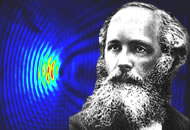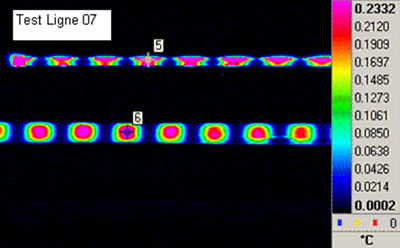Maxwell would have loved it
EMIR is a system used to map electromagnetic fields using infrared. James Maxwell, the founder of electromagnetism, would surely have loved it...
Number 44
|
|
Have you ever seen a magnetic field? Or an electric field? No, they are invisible, which can only be detected by the effects that they have on objects, for example a magnet in a magnetic field. However, Onera researchers have successfully developed a system to visualize electromagnetic fields (combining an electric field and a magnetic field). In the past, to arrive at the same result, a large number of sensors had to be deployed in many places within a room in order to define the field point by point. |
|
The Emir principle (Electromagnetic and Infra-red) is simple: an electromagnetic wave interacts with the conducting objects and heats them: this is the Joule effect. This is what happens in a microwave oven for example. In this case, a very thin, lightly conducting film is used. This film heats up slightly, and we film the heating up with an infra-red camera (capable of seeing temperature differences).
Emir is used to measure electromagnetic fields greater than 10 to 30 volts per meter. The norms governing the maximum electromagnetic fields authorized near electrical equipment are of this order of magnitude. This technique could therefore be used to check that the units comply with the norm. "We are trying to obtain greater sensitivity, to measure fields from 3 to 10 V/m," says François Issac. "To do this, we are working on signal processing, to improve the signal to noise ratio. We are looking at the magnetic field as well as the electric field, and we are trying to improve the quality of the films, so that they produce more infra-red radiation for a given field."
For the moment, Emir is used in Onera research laboratories mostly to make sure that there are no leaks when the magnetic field is to remain confined, or to make sure that it doesn’t penetrate into places where it shouldn’t, for example in the hold of a aircraft or a kerosene tank. This measurement is relatively expensive because of the price of ultra-sensitive infra-red cameras (of the order of 50,000 €), but it is easy to implement. "The Emir technique is unique in the world, and the principle is very clever," says Emmanuel Rosencher, Scientific Director of the Physics Branch at Onera. "For the first time, we can really visualize the electromagnetic field, which usually seems so mysterious. Until now, we only measured the electric field; now we can actually see the magnetic field. The image with which we can observe the electric field and the magnetic field in quadrature phase (one is strong when the other one is weak) is quite spectacular!" Cécile Michaut, scientific reporter. |
|


![L'expérience correspondant à l'image précédente où l'on a disposé des films (l'un conducteur, l'autre magnétique) dont les échauffements sont enregistrés par une caméra infrarouge, pour une onde TEM [Transverse électrique magnétique]](/sites/default/files/actualites/magazine/zoom_in_the_lab/44-emir-circe-champ-electrique-magnetique.jpg)